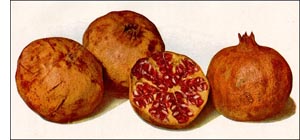Pomegranate fruit
 The Pomegranate is tree-like, growing to a height of about fifteen feet and in favorable soil even as high as twenty feet. It is probably native in Persia, though it is found in a wild state in all the countries bordering on the Mediterranean Sea.
The Pomegranate is tree-like, growing to a height of about fifteen feet and in favorable soil even as high as twenty feet. It is probably native in Persia, though it is found in a wild state in all the countries bordering on the Mediterranean Sea. It is also found in China and Japan, and has been brought by man to all of the civilized parts of the globe, where the climate is of a sufficiently high degree of warmth to permit the ripening of its fruit.
This little tree is frequently cultivated not alone for the beauty of its form, but for the beauty of its flowers, which, under cultivation, become doubled and show an increased and striking splendor in the richness of their color.
The pomegranate belongs to the family of plants called Lythraceae. This family has about three hundred and fifty species, which are widely distributed, but are most abundant in tropical regions, especially in America.
The color of the flowers, which develop on the ends of the younger branches, is a deep and rich scarlet or crimson. Many variations have been produced by growing the plants from seeds, and one of these bears white flowers. The petals are rounded and usually crumpled.
The fruit, which is a berry about the size of an ordinary orange, is, when fresh, usually of a reddish-yellow color, becoming brownish in drying. The rind is thick and leathery and encloses a quantity of pulp which is filled with a refreshing juice that is acid. It is of a pinkish or reddish color, and encloses the numerous angular seeds. Probably the chief value of the plant lies in the use of the fruit as a relish, though the rind of the fruit and the bark of the root are used in medicine.
The bark contains a large amount of tannin, and from it there is also obtained a bright yellow dye, which is used to produce the yellow Levant morocco. In regions without frost the tree is often grown for ornamental purposes.
Pommegranate picture